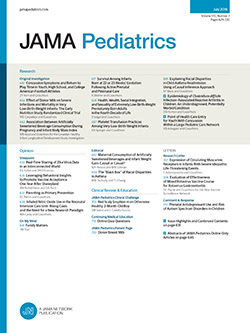Population-Level Effectiveness and Herd Protection 17 Years After HPV Vaccine Introduction.
IF 18
1区 医学
Q1 PEDIATRICS
引用次数: 0
Abstract
Importance Human papillomavirus (HPV) vaccine clinical trials demonstrate high vaccine efficacy, but postlicensure population-level effectiveness data are needed to inform vaccination and cancer-prevention recommendations and policies. Little is known about effectiveness in adolescent girls and young adult women at high risk for HPV-related cancers or after 9-valent HPV vaccine (9vHPV) introduction. Objective To examine effectiveness and herd protection over the first 17 years after HPV vaccine introduction in adolescent girls and young women at increased risk for HPV infection and related cancers. Design, Setting, and Participants This cross-sectional study analyzed data from 6 surveillance studies from 2006 to 2023. A consecutive sample of sexually experienced adolescent girls and young women aged 13 to 26 years was recruited from clinical settings. Exposure Participants were stratified by HPV vaccination status; those who received at least 1 vaccine dose were defined as vaccinated. Main Outcomes and Measures Effectiveness and herd protection were assessed by comparing proportions of vaccinated and unvaccinated participants positive for at least 1 type in the 2-valent vaccine (2vHPV), 4-valent vaccine (4vHPV), and 9vHPV in each of 6 studies. The prevalence of vaccine-type HPV was compared in vaccinated participants from surveillance studies 2 through 6 vs participants recruited in surveillance study 1, all of whom were unvaccinated. Inverse probability of treatment weighting with propensity score was used to balance between-wave differences in participant characteristics. Results Of 2335 participants (mean [SD] age, 18.9 [2.7] years; 1526 African American [65.4%], 13 Asian [0.6%], 6 Native American [0.3%], 582 White [24.9%], and 151 multiracial [6.5%]; 173 Hispanic [7.4%]), 1195 participants (51.2%) reported a sexually transmitted infection history and 1843 participants (78.9%) reported 2 or more male sex partners. Vaccination rates increased from 0 of 371 participants to 330 of 402 participants (82.1%) from 2006 to 2023. Among vaccinated participants, positivity decreased from 93 of 371 participants (27.7%) to 1 of 330 participants (0.4%) for 2vHPV (relative difference, 98.4%), 118 participants (35.4%) to 3 participants (2.1%) for 4vHPV (relative difference, 94.2%), and 163 participants (48.6%) to 21 participants (11.8%) for 9vHPV (relative difference, 75.7%). Among unvaccinated participants, positivity decreased from 93 of 371 participants (25.8%) to 3 of 72 participants (7.3%) for 2vHPV (relative difference, 71.6%), 118 participants (25.3%) to 4 participants (6.1%) for 4vHPV (relative difference, 75.8%), and 163 participants (42.7%) to 13 participants (31.1%) for 9vHPV (relative difference, 27.2%). For positivity rates, counts are raw numbers and percentages are propensity score adjusted. Adjusted logistic regression demonstrated significant reductions in the odds of at least 1 HPV type in the 2vHPV and 4vHPV among all (adjusted odds ratio [aOR], 0.03; 95% CI, 0.01 to 0.07 and aOR, 0.06; 95% CI, 0.03 to 0.10, respectively), vaccinated (aOR, 0.01; 95% CI, <0.01 to 0.05 and aOR, 0.04; 95% CI, 0.02 to 0.08, respectively), and unvaccinated (aOR, 0.23; 95% CI, 0.08 to 0.63 and aOR, 0.19; 95% CI, 0.07 to 0.52, respectively) participants and in the 9vHPV among all (aOR, 0.22; 95% CI 0.16 to 0.31) and vaccinated (aOR, 0.14; 95% CI 0.09 to 0.21) participants. Conclusions and Relevance In this study, population-level effectiveness and herd protection were robust 17 years after HPV vaccine introduction, even in sexually experienced adolescent girls and young women at relatively high risk for HPV who may not have received the full vaccination series.HPV疫苗引入17年后的人群水平有效性和群体保护。
重要意义人乳头瘤病毒(HPV)疫苗临床试验显示出较高的疫苗有效性,但需要获得许可后人群水平的有效性数据来为疫苗接种和癌症预防建议和政策提供信息。对于HPV相关癌症高风险的青春期女孩和年轻成年女性或引入9价HPV疫苗(9vHPV)后的有效性知之甚少。目的研究HPV疫苗在HPV感染和相关癌症风险增加的青春期女孩和年轻女性中引入后前17年的有效性和群体保护。设计、环境和参与者本横断面研究分析了2006年至2023年6项监测研究的数据。从临床环境中连续招募了有性经验的青春期女孩和年龄在13至26岁的年轻女性。暴露参与者按HPV疫苗接种状况分层;那些接种了至少一剂疫苗的人被定义为接种了疫苗。通过比较6项研究中接种疫苗和未接种疫苗的参与者在2价疫苗(2vHPV)、4价疫苗(4vHPV)和9价hpv中至少1种类型阳性的比例,评估了有效性和群体保护。比较了监测研究2至6中接种疫苗的参与者与监测研究1中招募的参与者中疫苗型HPV的患病率,所有参与者均未接种疫苗。使用倾向评分的治疗加权逆概率来平衡参与者特征的波间差异。结果在2335名参与者中(平均年龄18.9[2.7]岁,非洲裔美国人1526名[65.4%],亚洲人13名[0.6%],美洲原住民6名[0.3%],白人582名[24.9%],多种族151名[6.5%],西班牙裔173名[7.4%]),1195名(51.2%)报告有性传播感染史,1843名(78.9%)报告有2名或2名以上男性性伴侣。从2006年到2023年,疫苗接种率从371名参与者中的0名增加到402名参与者中的330名(82.1%)。在接种疫苗的参与者中,2vHPV的阳性从371名参与者中的93名(27.7%)下降到330名参与者中的1名(0.4%)(相对差异,98.4%),4vHPV的阳性从118名参与者(35.4%)下降到3名参与者(2.1%)(相对差异,94.2%),163名参与者(48.6%)下降到21名参与者(11.8%)(相对差异,75.7%)。在未接种疫苗的参与者中,2vHPV阳性从371名参与者中的93名(25.8%)减少到72名参与者中的3名(7.3%)(相对差异,71.6%),4vHPV阳性从118名参与者(25.3%)减少到4名参与者(6.1%)(相对差异,75.8%),9vHPV阳性从163名参与者(42.7%)减少到13名参与者(31.1%)(相对差异,27.2%)。对于阳性率,计数是原始数字,百分比是调整后的倾向得分。调整逻辑回归证明显著减少的可能性至少1人乳头状瘤病毒类型2 vhpv和4 vhpv在所有(调整优势比(aOR), 0.03; 95%可信区间,0.01 - 0.07和优势,0.06;95%可信区间,0.03 - 0.10,分别),接种疫苗(优势比,0.01;95%置信区间,< 0.01到0.05和优势,0.04;95%置信区间,0.02至0.08,分别),和未接种疫苗(优势比,0.23;95%置信区间,0.08 - 0.63和优势,0.19;95%可信区间,0.07 - 0.52,分别)9 vhpv在所有参与者和(优势比,0.22;95% CI 0.16至0.31)和接种疫苗(aOR, 0.14; 95% CI 0.09至0.21)的参与者。结论和相关性在这项研究中,在HPV疫苗引入17年后,人群水平的有效性和群体保护是强大的,即使在性经验丰富的青春期女孩和HPV风险相对较高的年轻女性中也是如此,她们可能没有接受过完整的疫苗接种系列。
本文章由计算机程序翻译,如有差异,请以英文原文为准。
求助全文
约1分钟内获得全文
求助全文
来源期刊

JAMA Pediatrics
PEDIATRICS-
CiteScore
31.60
自引率
1.90%
发文量
357
期刊介绍:
JAMA Pediatrics, the oldest continuously published pediatric journal in the US since 1911, is an international peer-reviewed publication and a part of the JAMA Network. Published weekly online and in 12 issues annually, it garners over 8.4 million article views and downloads yearly. All research articles become freely accessible online after 12 months without any author fees, and through the WHO's HINARI program, the online version is accessible to institutions in developing countries.
With a focus on advancing the health of infants, children, and adolescents, JAMA Pediatrics serves as a platform for discussing crucial issues and policies in child and adolescent health care. Leveraging the latest technology, it ensures timely access to information for its readers worldwide.
 求助内容:
求助内容: 应助结果提醒方式:
应助结果提醒方式:


